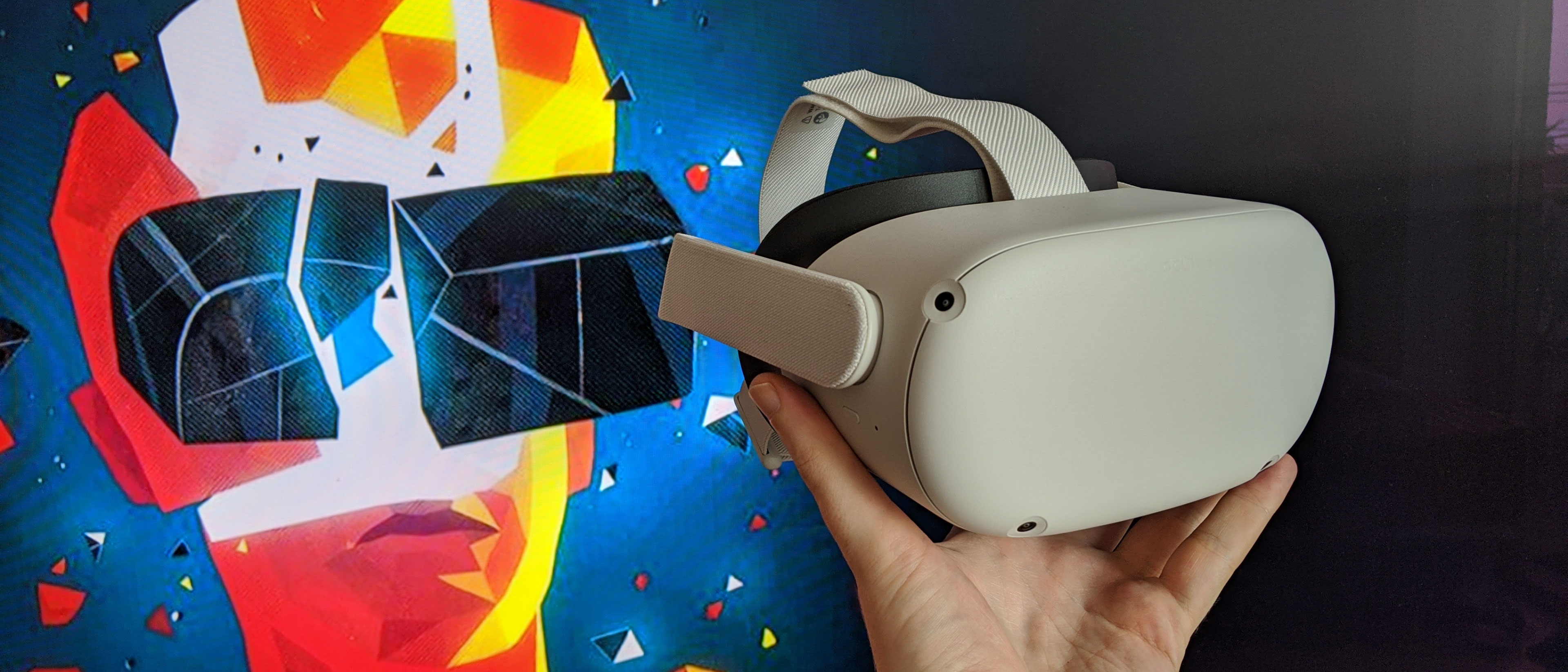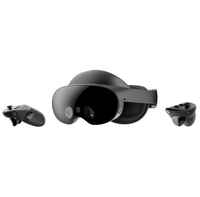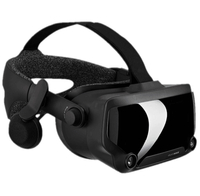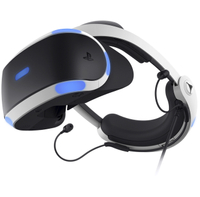TechRadar Verdict
Lightweight, comfortable, and powerful enough to run impressively detailed virtual reality experiences, the Oculus Quest 2 is the best VR headset that Oculus has made so far. And, depending on your perspective on raw power versus portability and comfort, it might just be the best VR headset ever, too.
Pros
- +
Incredibly immersive experiences
- +
Comfortable weight
- +
Easy to use
Cons
- -
Requires Facebook account linking
- -
Can still cause motion sickness
- -
Some ads
Why you can trust TechRadar
Two-minute review
In January 2022, Meta renamed the Oculus Quest 2 headset to the Meta Quest 2. The hardware itself, reviewed here, remains the same.
The Oculus Quest 2 is one of the best VR headsets available for both beginners and seasoned VR veterans alike. In fact, we’d go so far as to say it’s a must-have device if you’re looking for a top-tier VR system that doesn’t require the additional wires, huge expense or added fuss of a PC-based VR setup, like the HTC Vive or now-discontinued Oculus Rift S. Now that the Meta Quest Pro now here, there's a solid chance we could be seeing discounts on the more accessible VR headset now, too.
But for how long will it remain top of the VR pile? Facebook (now called Meta) announced its latest VR headset – dubbed Project Cambria – at the Connect event last October. At the time the company explained that this new device will be home to groundbreaking technology that aims to help establish the earliest days of its ambitious 'metaverse'.
It's due to arrive sometime this year, but for now, Meta's Quest 2 VR device continues to rule the roost.
For starters, the standalone Quest 2 brings you easy access to everything that makes virtual reality special and well worth your time, delivering high-quality virtual reality experiences at a fair price to your front room with minimal set-up.
The Quest 2 allows you to (almost literally) step inside gaming worlds, as well as access 360-degree video content and apps covering all genres. This is a truly immersive gadget that even the most tech-shy members of your family can have a blast with – once they’ve eased themselves into it, that is (VR-induced motion sickness is real).
The Oculus Quest 2 VR headset is the second version of the Quest headset range. It’s similar to the original Oculus Quest in that it’s a battery-powered, standalone headset that allows you to freely roam around your physical and digital play spaces without fear of tripping over a wire.
But there are some significant changes that would make an upgrade well worth it if you currently already have the original Quest and you’re considering the Quest 2. The new model offers a more responsive experience overall, thanks to improved RAM and chip specs. It also has a higher resolution display, which is a whole 50% sharper than its predecessor. Combined, these upgrades make the Oculus Quest 2 experience even more seamless and immersive.
What's more, where the Quest 2 is concerned developers now have the option to make their games run at 90Hz and even 120Hz (this is important for increased comfort and even more realism while playing), and the headset itself is noticeably lighter than before, with double the battery life in the controllers.
Hand tracking – which arrived on the original Quest via a firmware update, but is baked into the Quest 2 from the off – is also highly impressive, though can feel a little like a work in progress at times.
There are hundreds of separately-sold Oculus Quest games – and some free ones too – available to play with the headset, including everything from shooters to puzzle games, fitness titles to meditation apps, there truly is something for everyone, even if levels of quality – and comfort – can vary depending on what you're watching and playing.
The Oculus Quest 2 also offers a social experience. Though some will shudder at the Facebook account requirement (more on this below) the Oculus Quest 2 is superb when playing with friends. Whether you choose to do that through online avatars, or in the same physical room thanks to the option to Google Cast whatever you’re viewing within your headset to a nearby TV.
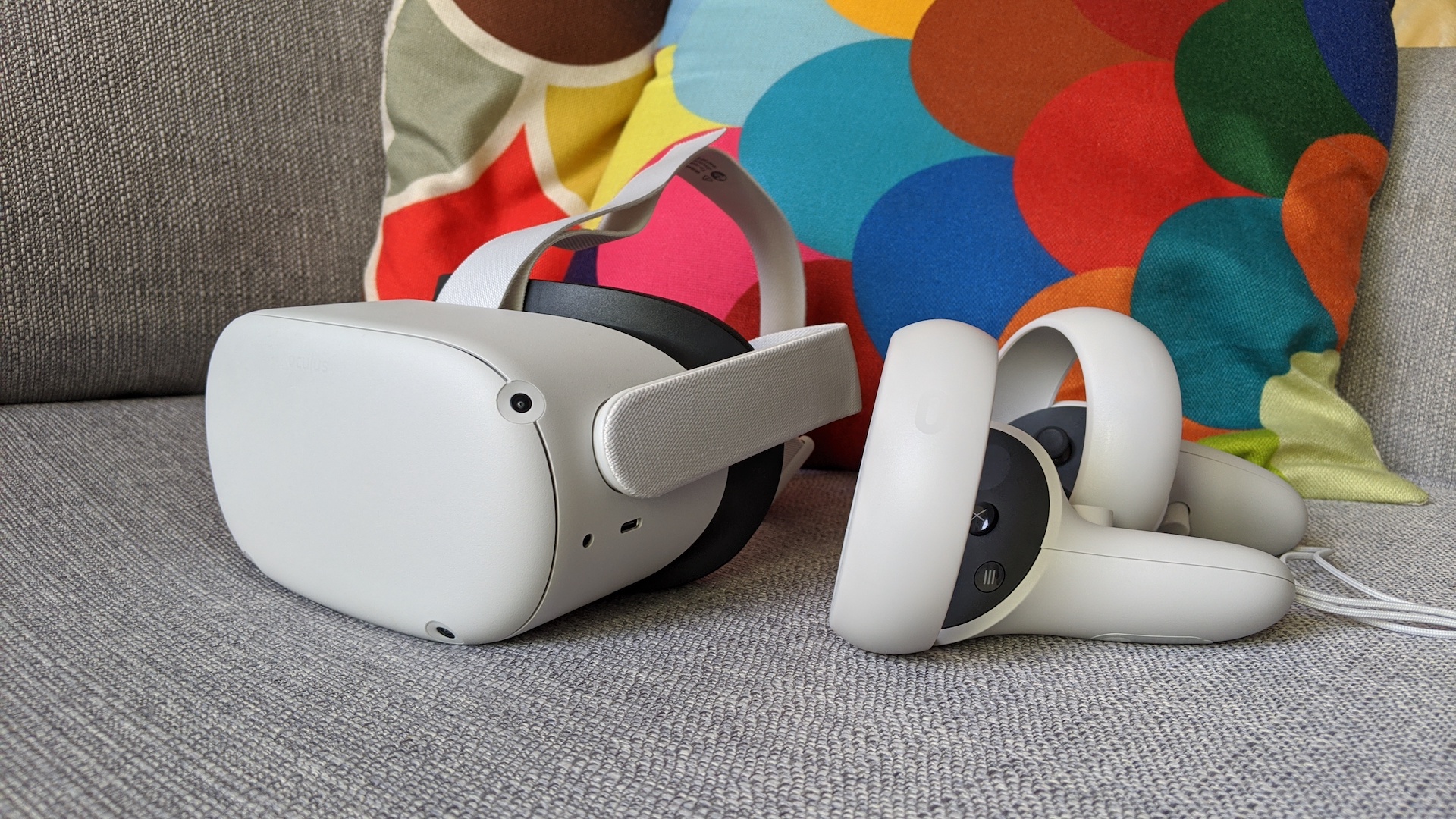
And yet, while Quest 2 is the most accessible and feature-rich VR headset we’ve tested to date, it still falls foul of some of the same pitfalls that virtual reality as a whole suffers from. There’s still the chance you’ll experience a degree of motion sickness, depending on your constitution, which is unavoidable on most headsets – even those that claim to have solved these problems – and might require you to introduce yourself to VR more gradually to avoid the telltale signs.
What's more, getting a good, tight fit to ensure the screen appears as clear as possible can be claustrophobic and a little uncomfortable. These base-level issues remain unsolved; for a new generation of hardware, we’d have liked to have seen a wider array of brand-new software to go with it, too.
Having said that, we are expecting more and more upgrades to the Quest 2 that might not address every niggling issue but could improve the VR experience even more. For example, the addition of 120Hz gaming for some titles didn't just make for smoother gaming but can reduce the chance you'll experience VR-induced motion sickness.
Oculus Quest 2 isn’t perfect, then – but it’s as close to perfect as VR has come so far and well worth your time, money, and energy if you’ve been looking for an excuse to swap reality for virtual reality.
Oculus Quest 2: price and availability
Following a few price changes the Oculus Quest 2 now comes in two variants: a model with 128GB of storage, priced at $400 / £400 / AU$630, and a 256GB version for $500 / £500 / AU$790.
While this is cheaper than the original entry-level Oculus Quest model launched it's more expensive than the Quest 2 has been previously. Before Meta brought in a price increase (caused by inflation and production costs going up) the 128GB model cost £299 / $299 / AU$479, and the 256GB version sold for £399 / $399 / AU$639.
The higher price for the Oculus Quest 2 does come with one new benefit though, you'll get a copy of one of the best Oculus Quest 2 games for free: Beat Saber. Buy a new Quest 2 before the end of 2022 and you'll be eligible to get a copy of the game at no charge.
Do check out the latest Meta Quest promo codes for ways to save some extra cash on the VR headset.
Oculus Quest 2: design
- Self-contained VR headset
- Improved resolution screen and processor
- Controllers have double battery life and thumb rest spaces
The Oculus Quest 2 is worn on the head, quite a bit like a scuba mask. Where a scuba mask’s window would be, you’ve instead got a padded cavity that houses a pair of goggle-like lenses that sit in front of a screen, giving you stereoscopic 3D visuals. Paired with motion sensors and accelerometers in the headset, you can move your head and see the motions reflected in real-time on the digital screen in front of you as if you were looking out and moving around in the real world.
It’s a similarly lightweight design to the first Oculus Quest (now available in white plastic rather than a dust-hugging, fabric-covered black) with its outer shell housing external cameras that help to track your positioning and that of the supplied controllers.
You tighten the headset with a velcro, slightly-elasticated fabric strap – a change (not necessarily for the better) from the more structured rubberized original.
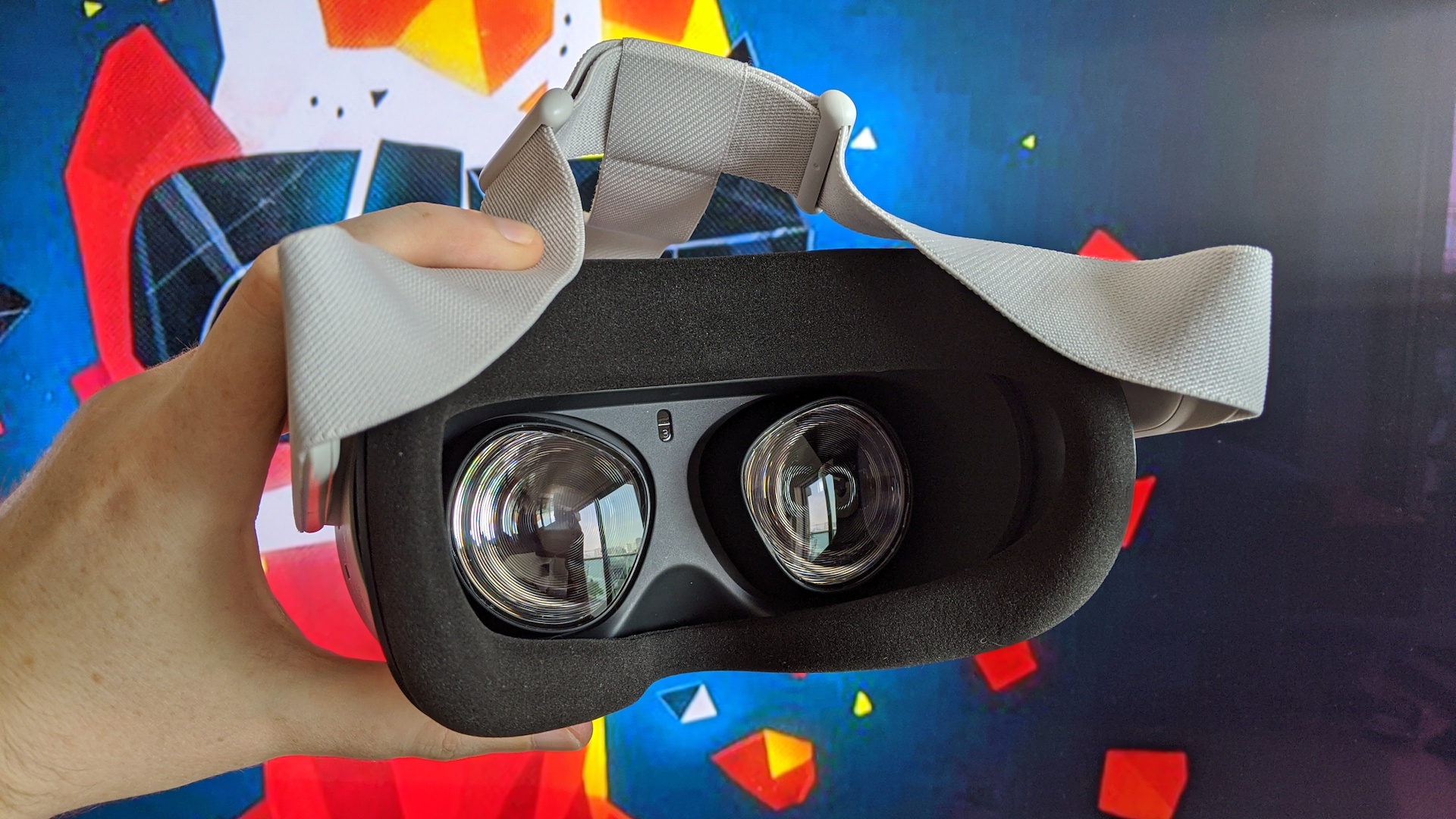
The internal improvements between the Quest 2 and the original Quest headset are significant. Compared to the original Quest, the Quest 2 offers 6GB of RAM compared to 4GB, and there’s a much faster Qualcomm Snapdragon XR2 chipset running the show. This allows for greater fidelity in experiences shown on the Quest 2, as well as allowing for boosted resolutions and refresh rates.
The first Oculus Quest made use of dual 1440 x 1600 resolution OLED displays (one for each eye), but the Quest 2 opts for a single LCD panel, split so as to display an 1832 x 1920 pixel resolution per eye. That’s about 50 percent sharper than the original, and while we’d usually prefer the richness of an OLED display, we hardly missed it here. LCD also opens up an improved refresh rate of 90Hz to developers, compared to the original Quest’s 72Hz - with an experimental feature bumping it up to 120Hz. Where supported, it will be a notably smoother experience.
Note though that there's a change to the Interpupillary distance (IPD, the gap between your pupils) slider on the Quest 2. Previously, you could make fine adjustments with a slider on the underside of the original Quest. Now you have to physically shift the goggles themselves over three pre-set distances, 58mm, 63mm, and 68mm. While most won't notice any difference (the three settings cover the most common IPD ranges), it's a shame that more delicate control has been lost.
The Quest 2 does all of this while still offering the same 2-3 hour battery life as the first Quest, depending on the application you’re using. That may not sound like much, but longer play sessions than that are unlikely to be comfortable anyway.
Oculus has managed this thanks to significant improvements to its tracking algorithms, which extend to the controllers too, now offering double the battery life (we’re talking weeks of constant play) compared to their predecessors.
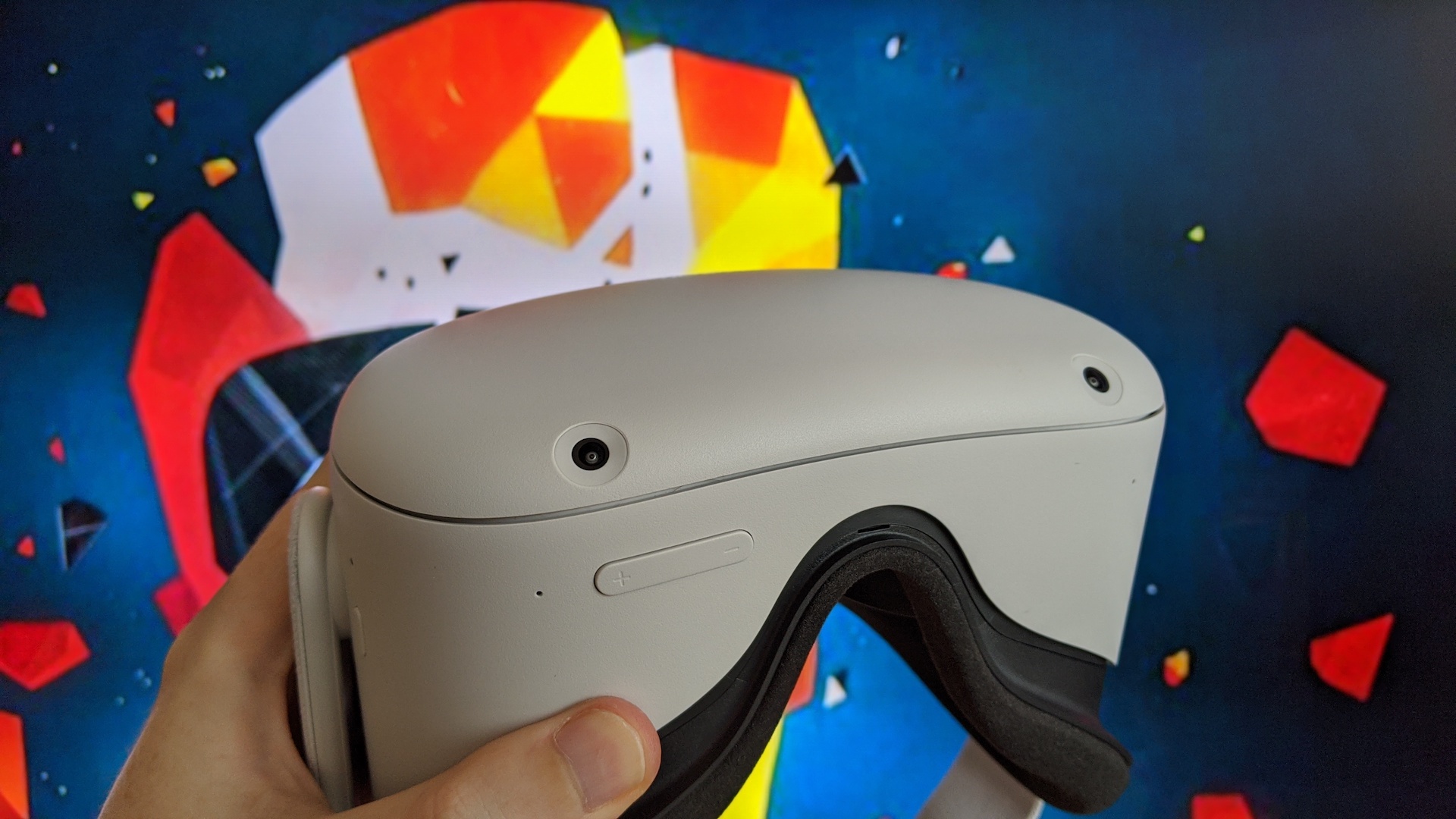
The motion controllers themselves have seen some small improvements too. Now available in white, they offer more room to rest your thumb during play, making them easier to hold for longer sessions. Each has a baton-like handle, including triggers for your forefingers and grips, as well as facial buttons and movement sticks for your thumbs. A strap keeps the controllers from flying free from your hand, while a plastic ring surrounds your thumbs, housing the near-invisible LEDs that allow the headset to track your hands’ and arms’ movements.
Speakers are built into the headset’s strap supports, offering directional left and right stereo sound. They’re reasonably clear and loud enough to get across the drama and directional audio feedback of your games, while keeping your ears free in order to allow you some awareness of your physical surroundings. Note that if you’re playing in a room with a friend, they’re going to hear everything going on using the built-in speakers, but there’s also a 3.5mm jack if you want to connect your own headphones for a private session.
A microphone is built in too, again clear enough for communicating in multiplayer games and doing some voice searches in the various UI elements of apps that support it. Speech recognition is surprisingly accurate, too.
Oculus Quest 2: using it
- Intuitive set-up and safety system
- Impressive hand tracking features
- Chromecast-enabled screen sharing
Getting a VR headset set up can be a painful affair – there’s usually loads of wires to plug in, and external sensors to arrange. But because all the computing and motion tracking is done on the self-contained Oculus Quest 2 headset, getting into the action here take just 5-10 minutes.
You’ll turn on the headset after its first charge, and be showed a few safety clips, and a very short intro video that introduces you to controllers and how their wand like point-and-trigger system can be used to navigate menus. You’ll then be asked to set up what's called a ‘Guardian' – the first of many 'wow' moments the Oculus Quest offers.
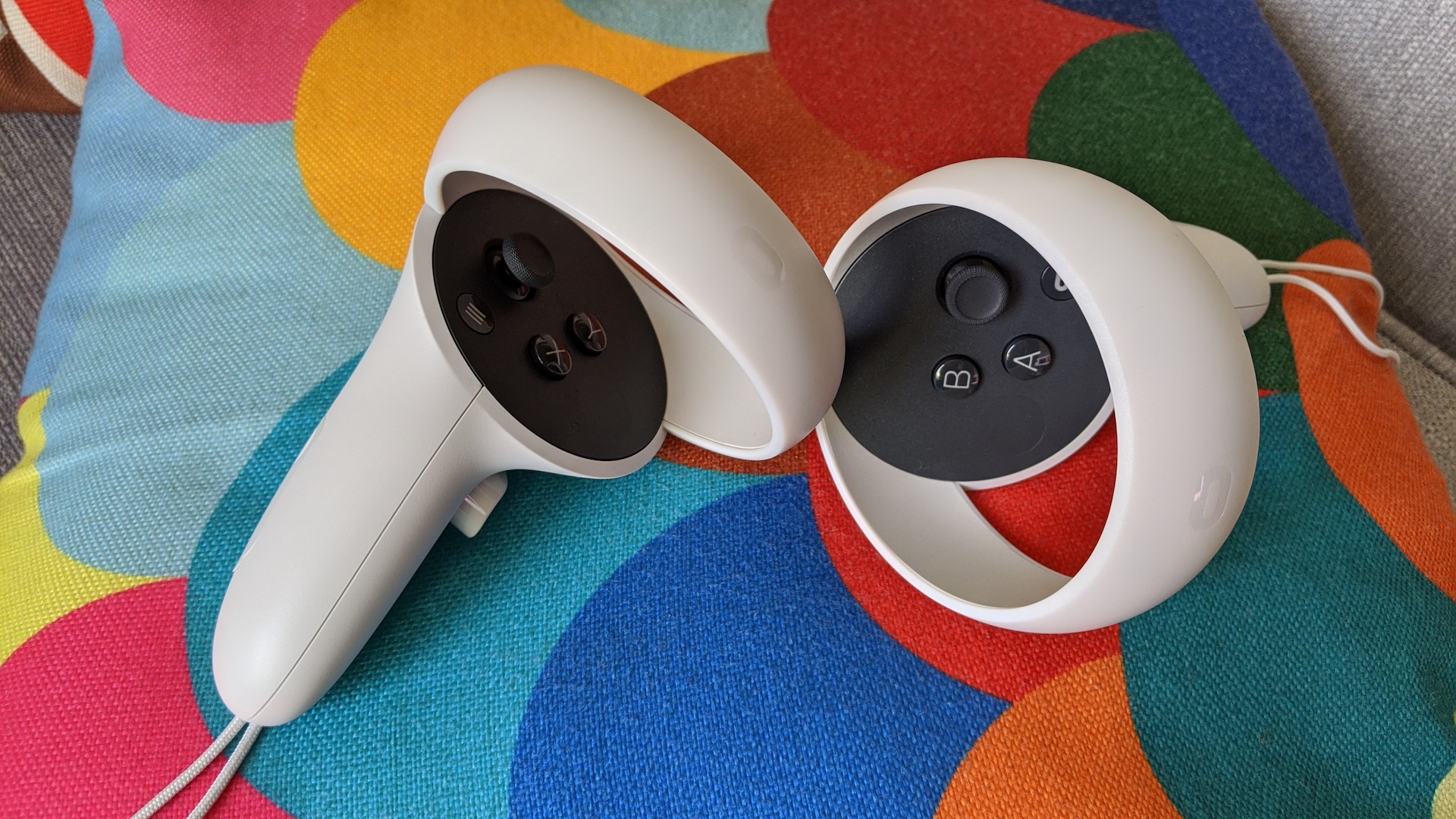
Using the headset’s external cameras, you’ll be shown a grayscale view of your surrounding environment on screen, in real-time. You’ll then use the controllers like a spray paint can, painting around the edges of your room to show the headset the safe play space you can freely walk about in without bumping into, say, your TV or sofa.
Stationary or seated settings are also available, but it’s these room-scale experiences that prove the most immersive. Oculus suggests a minimum space of 6.5 feet by 6.5 feet for room-scale titles, but you can probably get away with a bit smaller if you're careful. With the boundaries established, the Guardian wall is then revealed: a grid-like digital wall that only makes itself visible if you’re attempting to cross its boundaries. Here you’ll know the limit of safe play space, and if you stick your head through the digital wall, you’ll again see your real-world environment. It’s an ingenious safety feature.
The safety video animation below, which was revealed alongside the original Quest, does a good job of illustrating how it works:
With the Guardian set up, you’ll then be shown how to (optionally) use your hands to navigate menus, instead of using the controllers. Small movements like thumb and forefinger pinches can be used to select options and looking at your palm with fingers touching opens up menus. While the number of games using it remains limited, it's so intuitive that we're sure we'll see it used more and more in the future.
With set up out of the way, you’re into the Oculus menu system, which sits like a floating panel over your customizable ‘Oculus Home’ environment, a bit like a virtual living room.
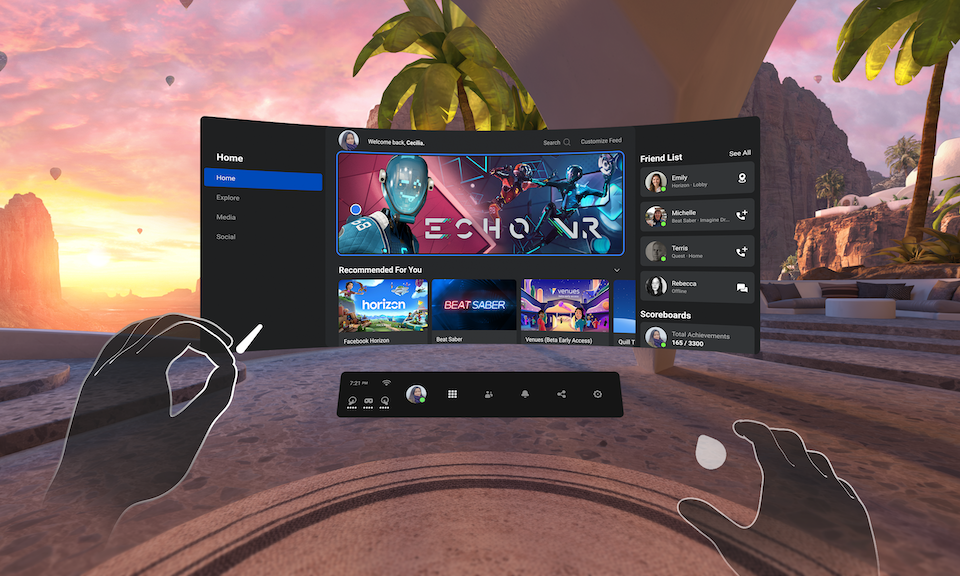
It’s here that you can browse app, game and video content, manage the storage on your headset, and connect with friends through Facebook. Note that a Facebook account is now an unavoidable part of the Oculus Quest experience, so if you’d rather not be a part of Zuckerberg’s data-harvesting empire, you’re going to have to pass on the headset entirely. It simply can’t be used without one.
There are plans to bring in a separate login method, however, we've not yet heard specifics of when this option will be available.
That moral quandary aside, it’s a smooth and easily navigable device. It also instantly shows just how far VR has come, especially mobile VR. Text is sharp and legible, and motion smooth and comfortable. While your field of view is narrowed by the goggles, it doesn’t take too long to get used to inhabiting the virtual space. For a newcomer, it’s breathtaking.
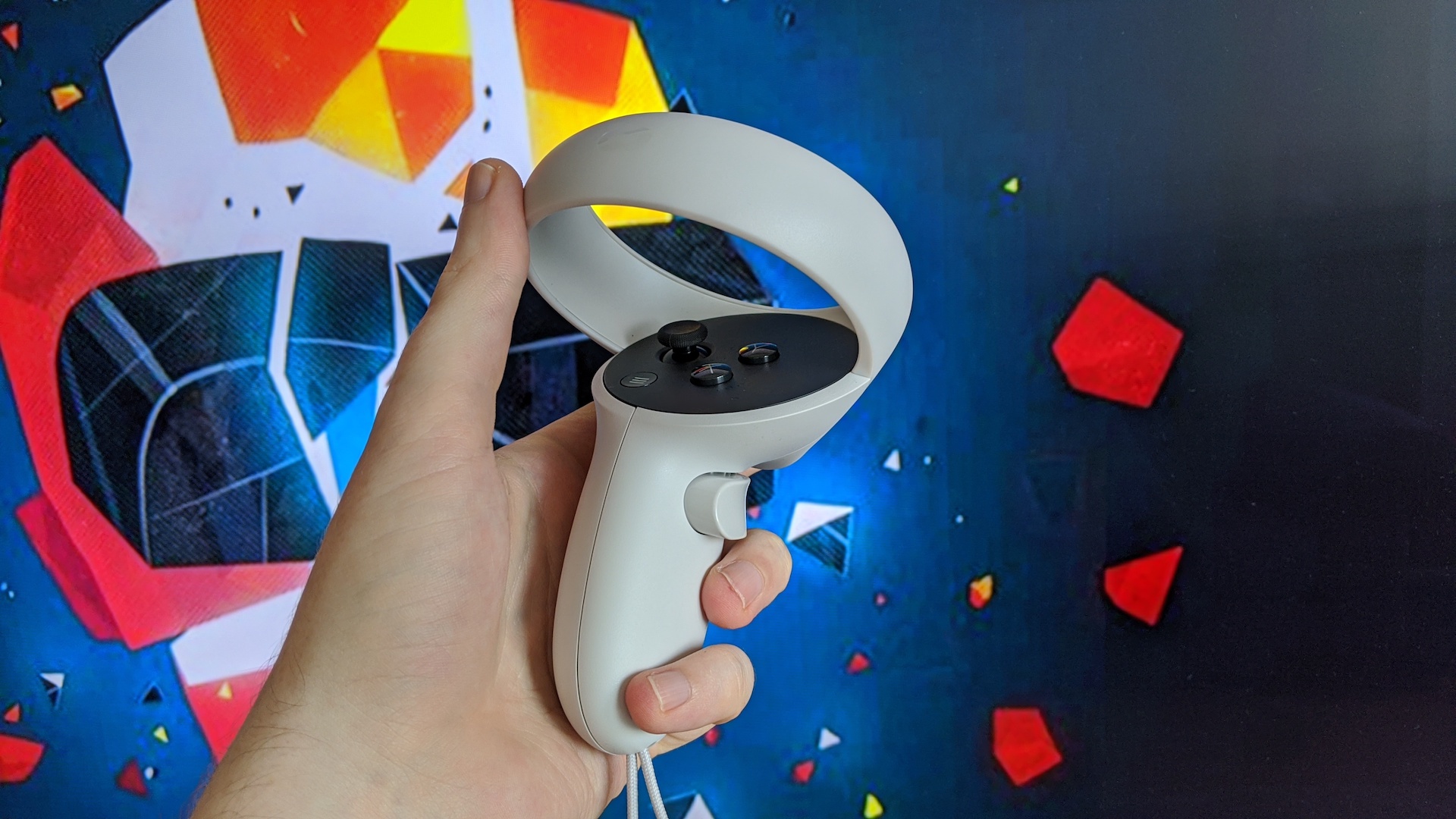
And while VR is often accused of being a solitary affair, Oculus has made strong efforts to make using Quest 2 in a group accessible. Like the original Quest, you can use the Google Chromecast screen sharing function within the Quest 2’s menu to allow someone not wearing the headset to watch what you’re up to on a second display like a smartphone or TV. Some games even actively encourage it, with one player taking charge of a role in the real world, while another navigates the VR world presented in the headset.
Oculus Quest 2: Software and apps
- Backwards compatible with original Quest games
- Immersive seated, standing and room-scale experiences
- Still has the capacity to make you feel nauseous
All Oculus Quest apps work on Oculus Quest 2, and most new applications will be backwards compatible with the original Quest (save for some high-end games like Resident Evil 4 VR).
As such, there was a healthy library of hundreds of games and apps available to Oculus Quest 2 at launch and that suite of titles has only grown. For some recommendations, you'll want to check out our best Oculus Quest 2 games, best VR horror games, and best VR fitness games lists.
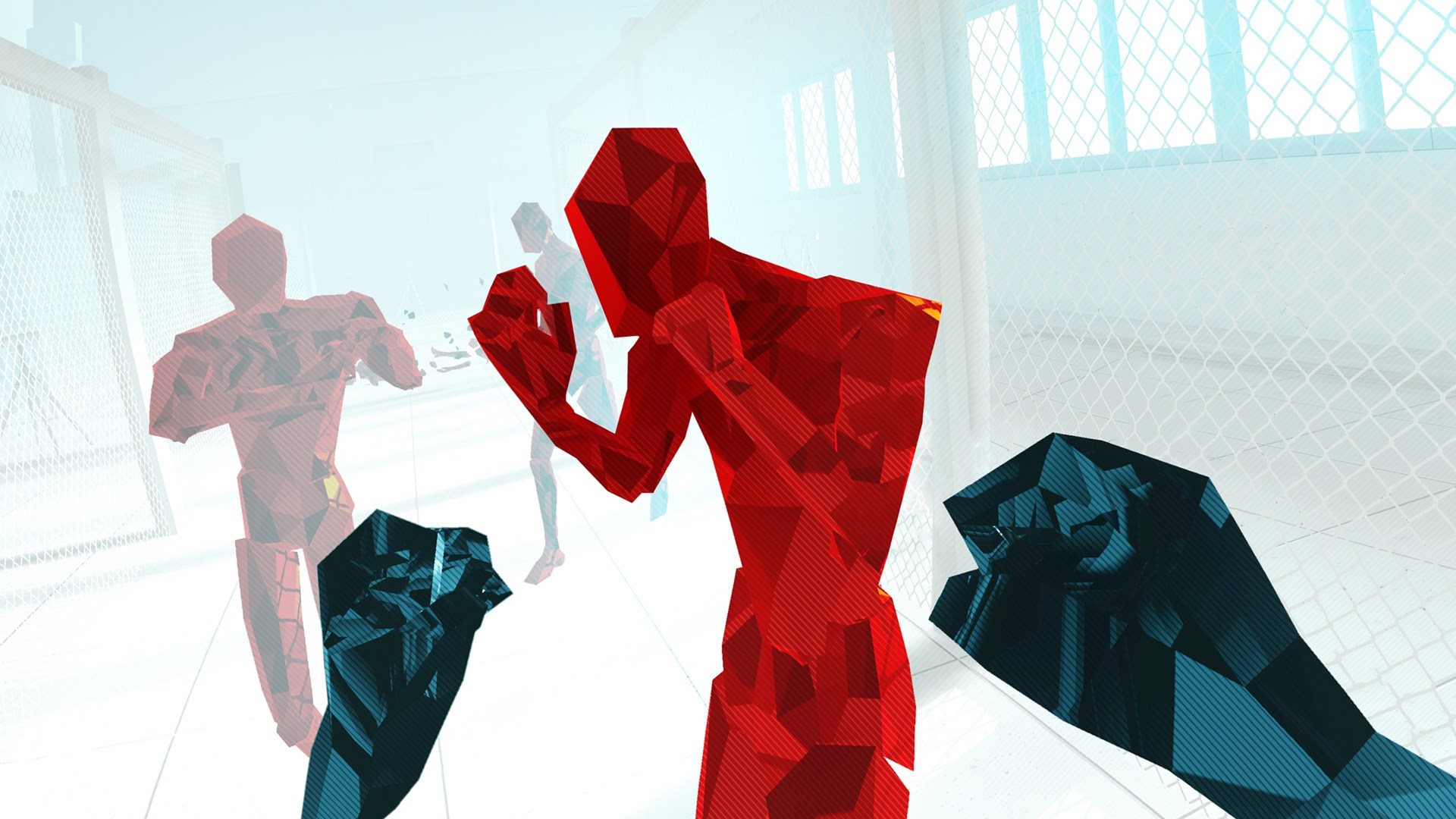
Oculus Quest 2 has access to some of the best virtual reality games that have been made. The range of inventive ideas on display is delightful, and with events like the Meta Quest Gaming Showcase becoming a yearly event we're seeing a healthy cadence of big titles appearing on the system.
It’s a wondrous experience losing yourself in the Quest 2, letting you really live within and feel connected to the games that you play. But the crucial question is… can you stomach it?
Some people can enjoy VR for hours without any complaint, while many feel symptoms akin to seasickness, caused by the disconnect between what your senses feel, and eyes see. While a tolerance to VR motion sickness can be built up over time, be prepared to limit your play sessions accordingly, or keep a bucket handy.
Many games thankfully have various comfort settings that can ease you in, such as snap turning, or features to make moving on the spot less sickening, so you should be able to find something that works for you.

But Quest 2 goes beyond games, of course. VR can be educational – there are applications talking you through historical moments, such as a touching look at the life of Anne Frank, and one letting you visit the Chernobyl disaster zone.
Virtual reality can be seen as an ‘empathy’ platform, letting you experience not only other worlds, but other lives and cultures. There are great apps from National Geographic and other organizations that let you visit locations around the world for a spot of virtual tourism, while also opening up the very real dangers of climate change. With fitness studios and meditation spots also available in app form, if you can visit it in the real world, there’s a good chance there’s a VR alternative being developed, or already in existence.
And then there are video players. The Quest comes with a built-in video player for side-loading your own clips onto, and there’s browser access, too.
Netflix, Amazon Prime Video, and YouTube are all also available to download, offering digital living rooms for you to watch titles on. YouTube VR is the best of the three – not only does it let you sit inside 360-degree videos and access the wealth of content uploaded to YouTube, it generally feels sharper, and gives you the option of pulling its massive screen closer to your seated position, as if you were at your very own personal IMAX screening.
Oculus Quest 2: PC tethering
- Access to high-quality PC VR experiences with Oculus Link feature
- Stands toe-to-toe with dedicated PC headsets
- Can access other VR gaming stores and platforms on PC
The Oculus Quest 2 rings the death knell for Oculus’s tethered, PC-only headsets, such as the Oculus Rift and Oculus Rift S. It has confirmed to TechRadar that, going forward, its headsets will offer a combination of mobile and PC tethered play, rather than being solely PC-tethered hardware.
Should you be lucky enough to have a decent-spec gaming PC, you can use the Oculus Quest 2 to tap into tethered virtual reality experiences powered by your computer. It’s simply a matter of plugging in a high-speed USB 3.0 cable to your headset, setting up the PC-based Oculus launcher and store on your computer, and grabbing the apps that take your fancy.
Alternatively, you can use the Quest 2's Air Link feature for a wireless PC VR experience.
Whichever method you choose this will dramatically increase the number of titles available to Oculus Quest 2 players, providing they have the PC hardware to power them. In addition, PC-based experiences, by virtue of the potential GPU horsepower behind them, can be more detailed and ambitious by an order of magnitude than their mobile counterparts.
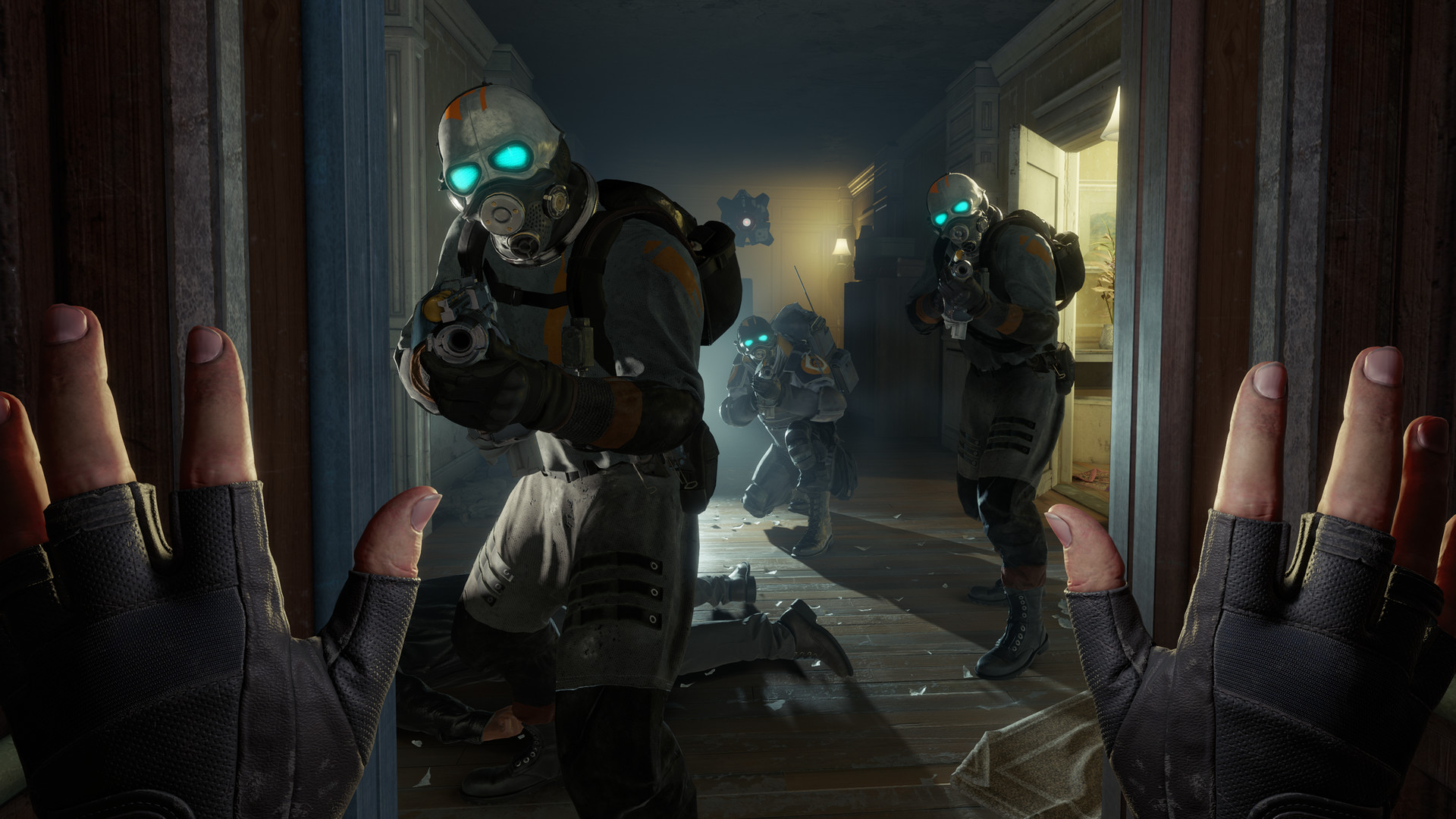
With the greater power of a PC at hand, the Quest is capable of taking advantage of some really impressive adventures, such as the god-stomping Asgard’s Wrath and mind-blowing Lone Echo 2. These are high-end VR adventures with graphical fidelity leagues ahead of the majority of Quest 2’s mobile apps and should be taken advantage of if possible. With a bit of tinkering, you can get the Quest 2 to play VR apps from other stores too, such as Steam VR’s highlight Half Life: Alyx.
Offering access to both these play scenarios through one headset line is a wise move by Facebook, reducing the amount of hardware it supports. However, as mobile VR now becomes the default for Oculus (not everyone has a gaming PC, after all), we hope that that doesn’t dull the ambitions of developers. We wouldn't want to see apps focus solely on the lower-powered mobile headset and give a cold shoulder to the more powerful made-for-PC experiences that can be achieved.
Oculus Quest 2: Accessories
New for the Oculus Quest is the introduction of a number of Oculus-licensed accessories beyond the controllers. These include a new, structured headband for an optional comfort fit, a headband with a built-in battery to double playtime, audio accessories from Logitech, and different inner faceplates for varying sizes.
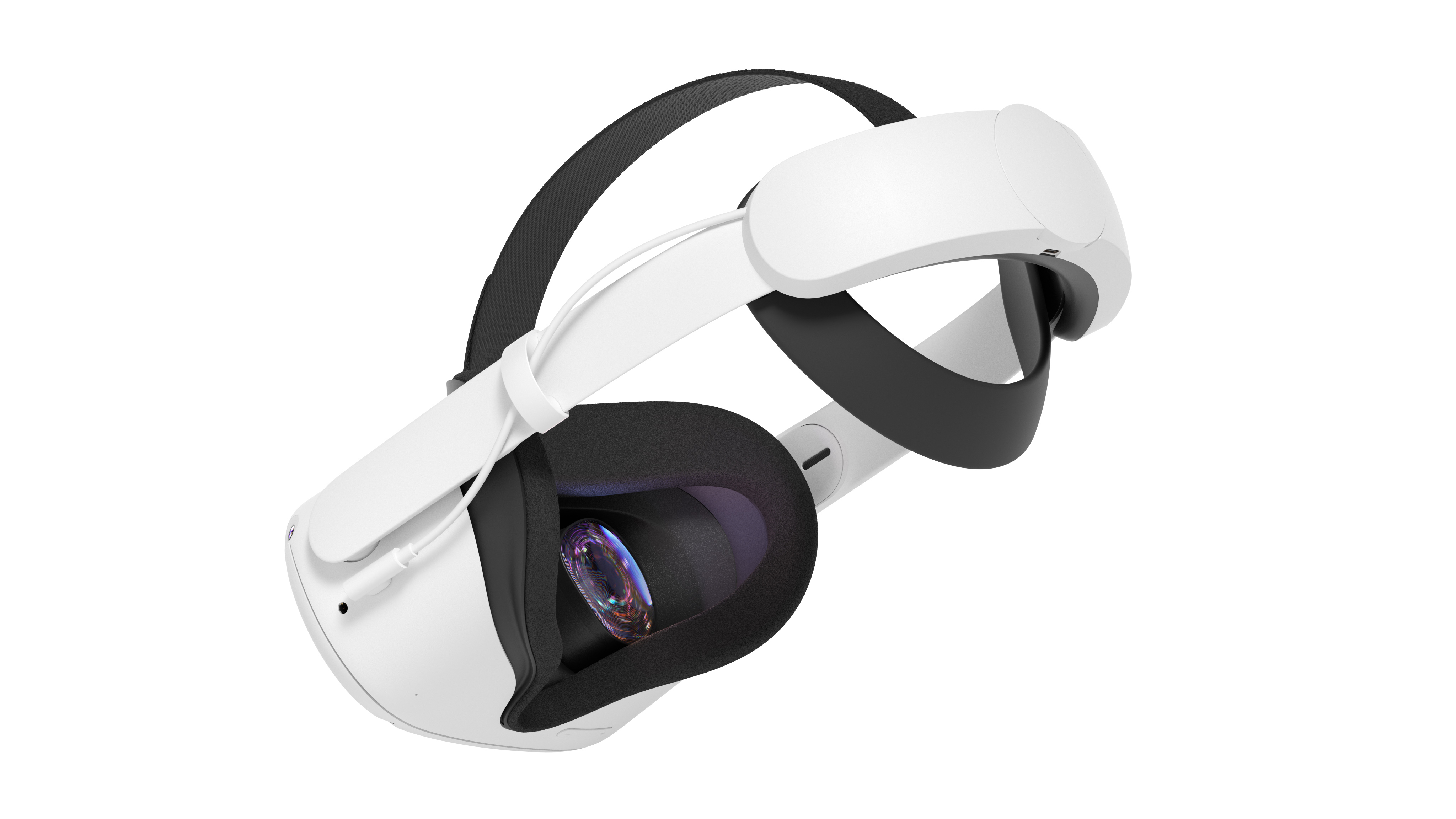
Our favorite is by far the Quest 2 strap with battery. Not only is it the best way to extend the battery life of your Oculus Quest 2, but the weight of the battery makes the headset feel less front-weighted, improving comfort.
The elite strap is also a solid add-on, but you'd be better off saving up and getting the strap with battery upgrade instead.
Buy it if...
You want an accessible, wire-free VR experience
Self-contained and remarkably easy to use, Oculus Quest 2 represents the very best of VR gaming and experiences, in a package that even a technological novice can set up and appreciate.
You have a VR-ready gaming PC
You’ll get even more bang for your buck if you’ve got a highly specified PC to hand, as plugging a cable into the Quest opens up access to tethered PC VR experiences, too.
You have a big play space to enjoy
Oculus Quest 2 can be enjoyed by anyone, thanks to the way it scales its Guardian room tracker from seated, to standing, to free roaming experiences. But Quest 2 is at its best when you’ve got a large (indoor) space to roam around, free of obstacles to break the illusion of wandering around a digital world.
Don't buy it if...
You don’t want to be tied to Facebook
Oculus’s recent changes to its User Agreement means that you must have a Facebook account activated in order to use the Quest 2. That brings with it Facebook’s data monitoring practices, so if you’re not a fan of that scenario, you’re out of luck.
You’re easily nauseated
It’ll vary from person to person, but certain virtual reality experiences still have the capacity to make you feel a bit nauseous. There’s lots of ways to minimise this effect, including not playing racing or flying games, but it’s a consideration that doesn’t usually have to be made with other platforms and media.
You’ve already got the original Oculus Quest
There’s lots to love about the new Quest, but if you’re an owner of the original model, you shouldn’t feel left too far behind by the introduction of this new version.
Also consider...
Meta Quest Pro
Meta's latest VR headset costs a fair amount more than the budget-friendly Quest 2, but its performance upgrades and suite of new features (like color passthrough and eye-tracking) make it a great pick for those looking to splash out on a VR device.
Check out our Meta Quest Pro review
Valve Index
If you have a beefy PC set up and a decent-sized budget you could try the Valve Index. This headset's more impressive specs allow it to deliver some great VR experiences, though you will miss out on the Quest 2's exclusive library of games like Resident Evil 4 VR.
Check out our Valve Index review
PlayStation VR
If you have a PS5 or a PS4 then you might want to consider picking up the PSVR headset instead. It's generally a bit cheaper and can offer you a new way to enjoy games you may already own like Resident Evil 7 and Star Wars Squadrons. Though with the PSVR 2 headset coming soon you might want to hold off a little longer.
Check out our PlayStation VR review
First reviewed
Oculus Quest 2: Recent updates
Right now, we're still awaiting further news on Meta's next two headsets, Project Cambria and Oculus Quest 3 (also known as the Meta Quest 3). In the meantime thought, we've seen some unusual accessories being developed for the existing Quest 2 headset, including one which suffocates you to better simulate firefighting in virtual reality.
Otherwise, if you're looking to get the most out of Meta's current headset, we're here to help. We know that Ghostbusters VR is coming to Oculus Quest 2 soon, and Among Us VR is coming to Oculus Quest 2 as well. There's plenty to look forward to, so if you're hoping to use it on PC too, we're here to help. Thanks to Oculus Link, you can play Steam VR games with Oculus Quest 2, and here's our guide on how to connect Oculus Quest 2 to a PC.
Gerald is Editor-in-Chief of iMore.com. Previously he was the Executive Editor for TechRadar, taking care of the site's home cinema, gaming, smart home, entertainment and audio output. He loves gaming, but don't expect him to play with you unless your console is hooked up to a 4K HDR screen and a 7.1 surround system. Before TechRadar, Gerald was Editor of Gizmodo UK. He is also the author of 'Get Technology: Upgrade Your Future', published by Aurum Press.
- Hamish HectorSenior Staff Writer, News
